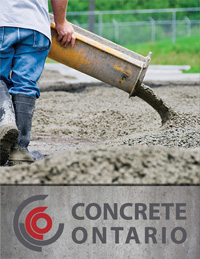The voice of a sustainable industry
By Cheryl Long
It’s easy to take concrete for granted. It’s underneath our feet in the foundations of our homes, it’s used to construct some of our major roadways and there’s something reassuring about knowing that the strength of our bridges and overpassesrelies on such an age-old material.
Concrete dates back thousands of years, though history says the Romans were first to use large amounts of the material extensivelyduring the Roman Empire. Trading in their traditional stone and brick for concrete allowed builders to come up with revolutionary new designs, some of which still stand today such as the Pantheon in Rome, Italy.
The Ready Mixed Concrete Association of Ontario (RMCAO) is the voice of the province’s concrete and construction industries, representing more than 96 percent of all concrete production and manufacturing. Formed in 1959, the non-profit association works to spread the word about education, technology, research and innovation to architects, designers, contractors and concrete companies. Though concrete has been around for centuries, work is still being done to spread its reputation as a sustainable material with an impressive lifecycle.
From RMCAO to Concrete Ontario
In an effort to better communicate the attributes of their product, RMCAO recently rebranded under the name Concrete Ontario, said Chris Conway, the association’s President & CEO. The Mississauga-based organization has been using the Concrete Ontario name in their social media for several years, and the move to the new name will allow the association to extend its reach throughout the industry. And the industry is not a small player, generating about $3.2 billion in revenue annually and providing approximately 12,000 jobs.
The long-term vision is to “increase the awareness of concrete as a product andget us back in some of the discussions that are going on within commercial real estate, within some of the other groups about the benefits and some of the work that’s been done,” Conway said. “I think they’ve done some great work, like the ECO certification, which is 260+ plants. It’s quite a bit of work for a small group of people to get done and (they need to) really communicate that.”
Concrete Ontario represents almost the entire industry with a membership that ranges from large vertically integrated companies like Lafarge right down to the many small independent businesses operating throughout the province. Due to the nature of concrete — it has to be delivered to the construction site within two hours of being mixed — their membership is “geographically dispersed” among nearly 300 plants in Ontario. That puts Conway on the road on a regular basis as he strives to meet as many of the association’s members in person as possible. From Thunder Bay to Kingston to Wallaceburg, Conway is seeing firsthand how Ontario’s concrete plants are faring from region to region.
Companies attain eco certification
What makes Concrete Ontario’s members stand out among other industry associations is their compliance with the RMCAO Facility Certification, which includes an “eco” component addressing Ministry of Environment requirements. Two-thirds of the membership went beyond the basic ECO level, Conway said, meeting optional best practice requirements for an ECO Gold Certification.
One of the challenges facing the industry revolves around awareness, Conway said. The benefits of concrete in terms of lifecycle and sustainability hasn’t always been well-communicated, he explained, and the association is working to demonstrate the cost savings and long-term benefits that can result when concrete is used in place of more traditional materials. Among Concrete Ontario’s seven-member team is a pavement engineer who is instrumental in using lifecycle analysis to demonstrate the value of concrete as a construction material. A project taking place within the industry is the creation of about 50 concrete mix designs that adhere to LEED standards. Then there’s the introduction of concrete in projects like wind turbines, roads and parking lots.
Highway 407 is a prime example of the advantages of concrete over asphalt. Not only is it less plagued by seasonal potholes, but it makes night driving safer due to its increased reflectivity, Conway said. The same holds true for parking lots. The City of Windsor is an example of a municipality that has embraced the benefits of concrete for paving, he added.
Concrete for roads a feasible option
“If you have asphalt getting eight to 12 years now on average before it has to be replaced, with concrete you can get 40 and 50 in some cases,” he said. As long as it’s cured correctly, concrete requires little repair, can be driven on the day after it’s poured and holds up well against Canada’s climate. Even the cost of concrete versus other materials like asphalt is becoming more competitive, particularly when its maintenance and lifecycle is taken into account.
The association also promotes safety within both the industry and the community, operating an RCMAO Safe Driving Award program and also providing 5,000 truck safety posters to Ontario schools that show children how to move safety around construction vehicles. There’s a pilot program in place to outfit trucks with 360-degree cameras and install guards on the rear wheels. Dashboard cameras are another feature that can help clear up any confusion in the case of an accident.
Concrete Ontario is working steadily to promote its product as a sustainable and long-lasting option, highlight the importance of safety throughout the industry and find new ways to support its membership. Simply put, “it’s an industry on the right side of things.”
More information on Concrete Ontario can be found at www.rmcao.org.







